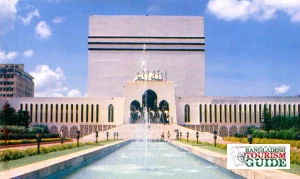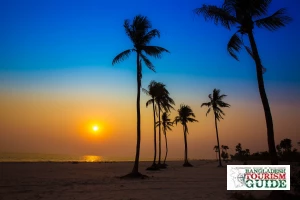Description:
Every country has some special architecture that attracts both domestic and foreign tourists. Similarly Ahsan Manzil of Dhaka is also famous for its amazing architecture and history. While there are fewer people on weekdays, it is crowded on holidays.
Location:
Ahsan Manzil is located on the banks of the Buriganga River in Kumartuli, Islampur, Old Dhaka. It takes 20 minutes by motorized vehicle and 35 minutes by rickshaw from Dhaka's Gulistan. Also, you can come directly to Ahsan Manzil from any part of Dhaka by CNG.
History:
Ahsan Manzil was formerly the residential palace of the Nawabs of Dhaka and the headquarters of Zamindari. The builder of this palace was Nawab Abdul Ghani. He named this palace after his son Khwaja Ahsanullah. The construction of Ahsan Manzil started in 1859 AD and was completed in 1872 AD. It was decided to establish the Muslim League in a meeting held here in 1906 AD. Ahsan Manzil has been renovated several times. The last renovation was done very recently.
During the Mughal era, there was a garden house of Sheikh Enayetullah, zamindar of Jamalpur Pargona, at this place. Sheikh Enayetullah was a very charming person. He acquired a very large plot of land at Kumortuli (Kumartuli) and incorporated it into his garden house. Here he built a beautiful palace and named it "Rangamhol" (Rangmahal). He used to enjoy adorning the beautiful girls he collected here from all over the country with beautiful clothes and expensive ornaments. There is a story that the fauzdar (representative of the Mughal emperor) of Dhaka was attracted to a beautiful girl. He invited Sheikh Enayatullah to a party one night and conspired to kill him on his way back home. That girl also committed suicide in anger and grief.
Probably around 1940 CE during the reign of Nawab Alibardi Khan, Sheikh Enayetullah's son Sheikh Matiullah sold the property to French traders. Adjacent to this property was a French trading house. The trading house became rich after buying this property. At that time French traders could trade here without paying any duty as per the order of Emperor Aurangzeb. At that time, the French, English and other European companies became very rich by trading here, and they built a new palace and dug a pond for fresh water on the newly purchased property. The pond still exists in Ahsan Manzil's compound which was called "Les Jal" at that time. The French were defeated in the Anglo-French War and all their possessions were captured by the British on 22 June 1757. Then in 1830, Kumartuli's trading house was bought by Khwaja Alimullah, an established zamindar of Dhaka. After some renovation work, the trading house became the residence of Khwaja Alimullah. During his time, a stable and a family mosque were added to the premises. After his death, his son Khwaja Abdul Ghani acquired a large fortune in this property and named his son Khwaja Ahsanullah "Ahsan Manzil". On the east side of the old building, he built a new building with a different design and also did great renovation work on the old building. Since then, the old building was called "Onder Mohol" and the new building was called "Rong Mohol".
Attractions:
Architecture:
This magnificent palace has a beautiful dome on the roof. This dome was the highest peak of ancient Dhaka. The tri-arched entrance outside the main building is also beautiful. Similarly, the stairs going up attract everyone's attention. There are two graceful arches at the east and west ends which are most beautiful. Ahsan Manzil has two parts inside. The meeting room and library are in the eastern part. The western part has the ballroom and other living rooms. The ground floor has the courtroom and dining room. The two-storied palace building on a 1 meter high altar measures 125.4 meters and 28.75 meters. The height from floor to ceiling is 5 meters on the ground floor and 5.8 meters on the second floor. On the north and south sides of the palace are car balconies as high as one floor. A large open staircase leads from the second-floor balcony over the south-facing carport to the riverside garden. There was a fountain in the garden in front of the stairs, which is not there now. Both the floors of the palace have wide balconies with semi-circular arches on the north and south sides. The balconies and floors of the rooms are decorated with marble stones.
Why go to Ahsan Manzil:
Ahsan Manzil is a very good tourist destination for those who love construction or architecture. Ahsan Manzil is also called the Pink Palace because its exterior is painted pink. The youth of the present generation are looking for interesting places to take pictures, Ahsan Manzil can be a great place for them.
Conclusion:
There are two buildings here. One is 'Pasad Bhawan' and the other is 'Andar Mahal'. Of these there are 22 galleries in the palace building. And 22 galleries have about 2000 works of art and artifacts. It can be an aesthetic place for tourists. Both its indoor and outdoor spaces are very pleasant.












